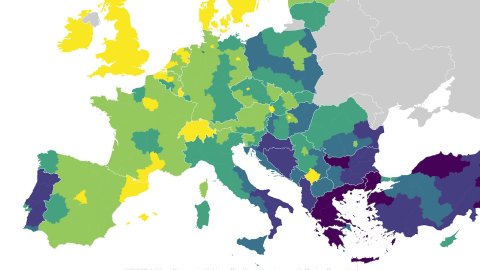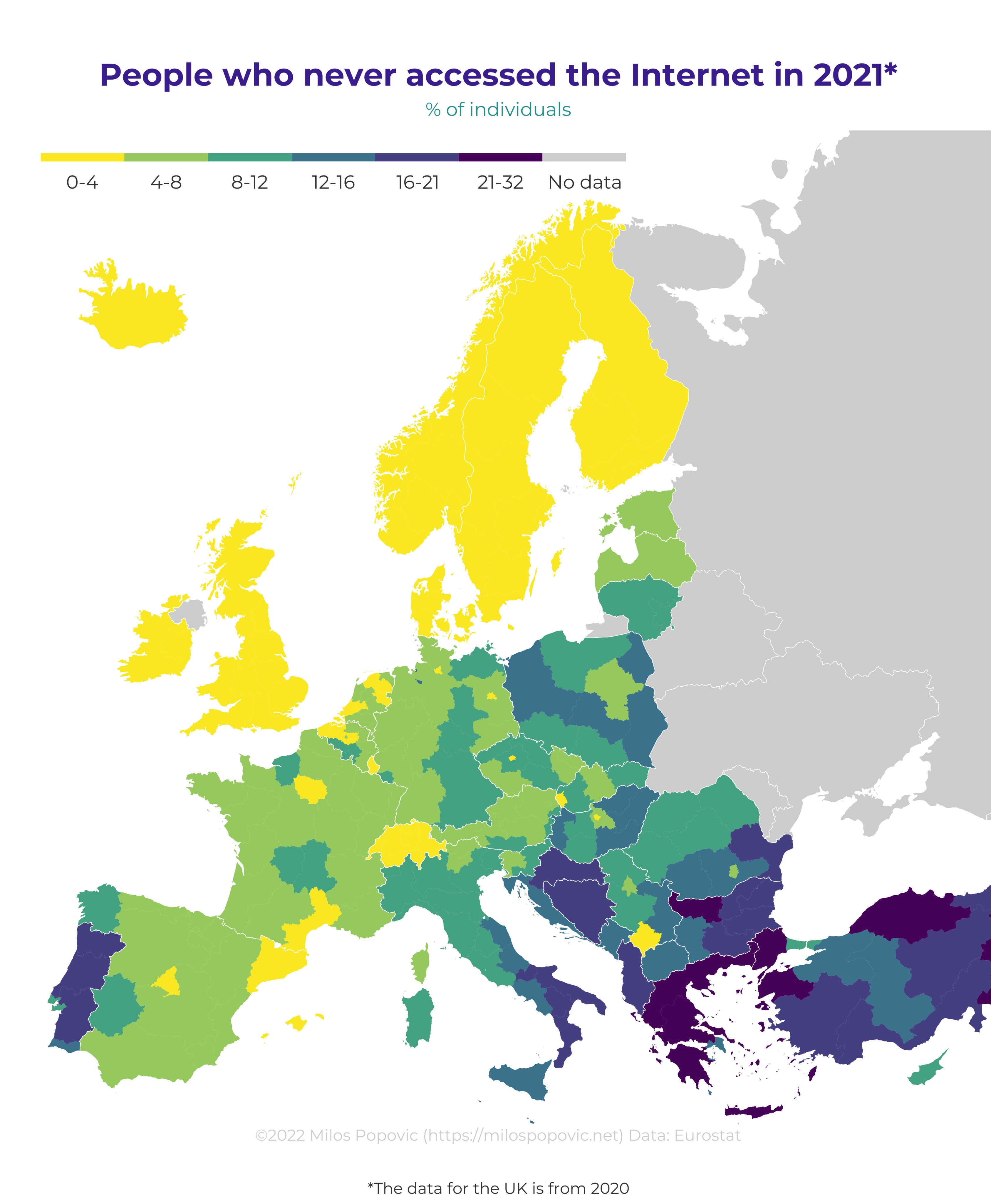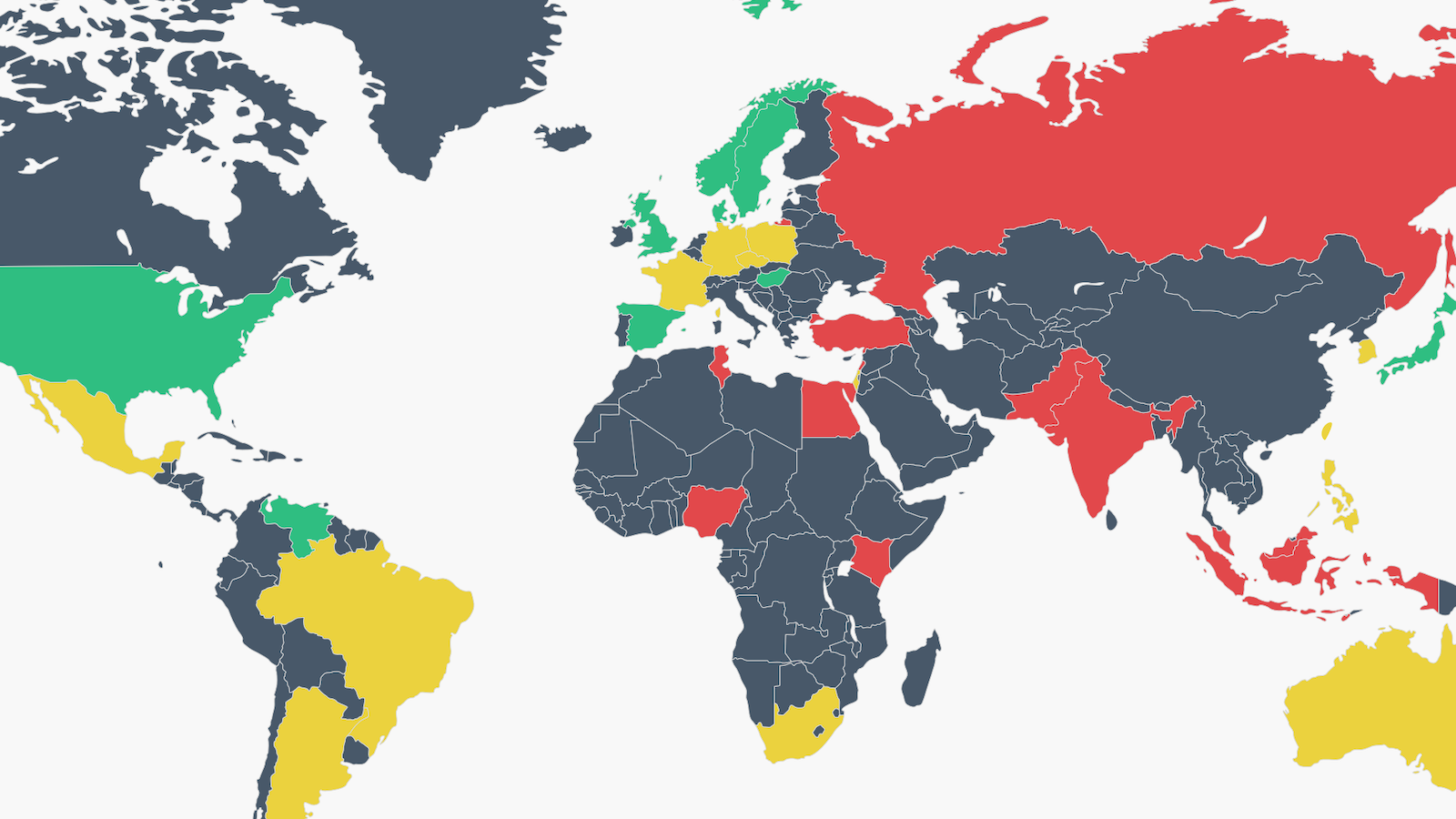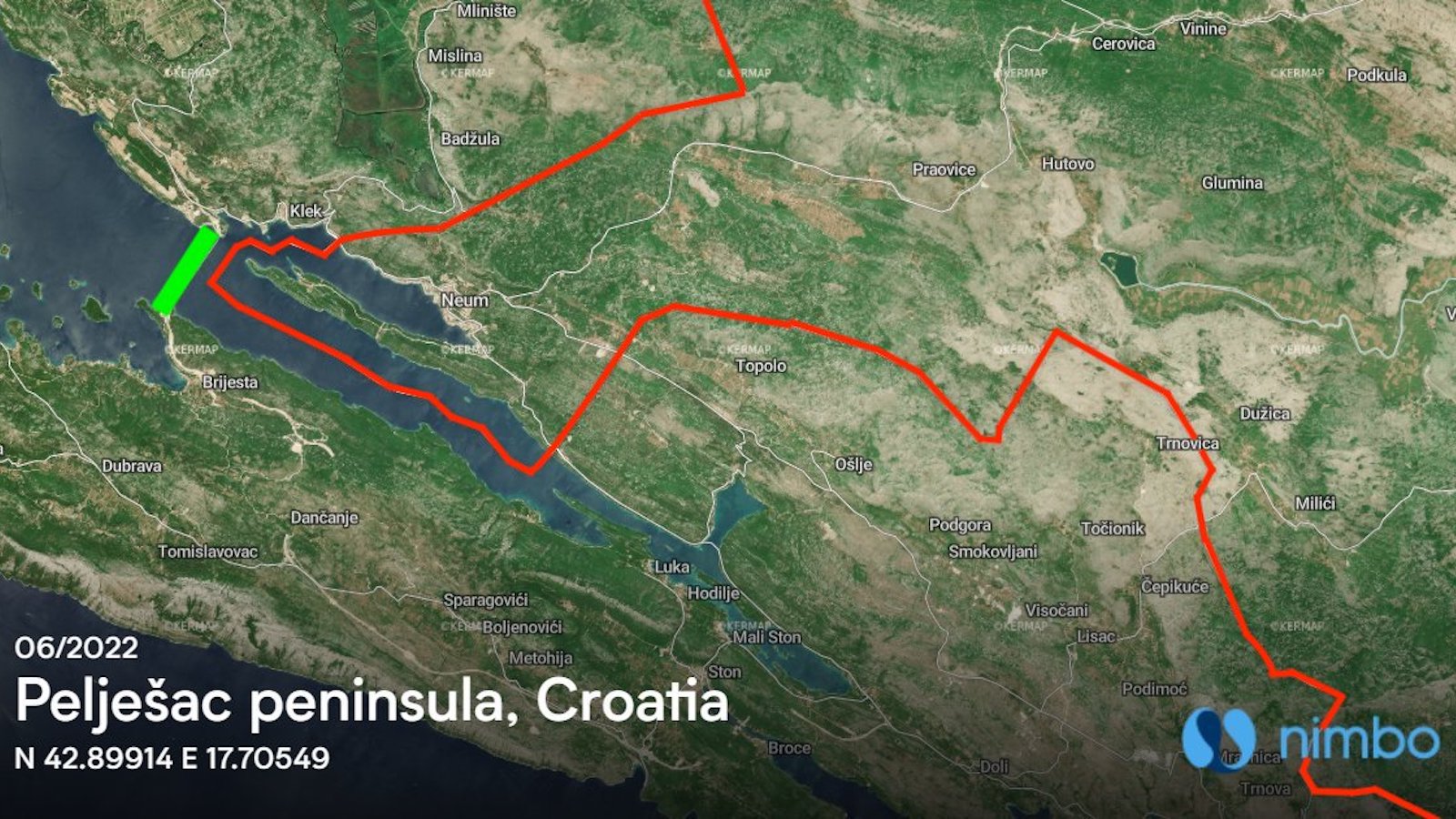Europe’s stunning digital divide, in one map

- In 2021, just 8% of the EU’s population had never used the internet.
- But that figure varies widely, with markedly more holdouts in the southeast.
- It won’t last. As access improves and older people die, internet usage will be at or near 100%.
It’s not just the spear-shaking Sentinelese or the adamantly analog Amish who shun the 21st century. There are also a considerable contingent of Europeans who still don’t use the internet. As this map illustrates, Europe’s offliners are concentrated in the southeast of the continent. On the other hand, almost everyone in northwestern Europe is online.
Never accessed the internet
The map shows the share of people in regions and countries across Europe who have “never” accessed the internet. It is based on data for 2021 from Eurostat, the EU’s statistical agency. And it clearly shows a glaring digital divide across Europe. (To clarify, this map also shows data from non-EU states, like the UK, Switzerland, and Turkey.)
The highest scores for internet non-usage (21%-32%) were achieved in the darkest zones on the map: almost all of Greece (except for the Athens region), several regions in Turkey, and northwestern Bulgaria.

The next level of scores (16%-21%) turns parts of Romania and southern Italy a slightly lighter shade of blue, plus most of Croatia, Bulgaria, Turkey, and Portugal, as well as all of Bosnia and Albania. One shade lighter (12%-16%) consumes Cyprus, the rest of Turkey, and most of the southern Balkans — and roughly half of Hungary and Poland.
The Kosovo surprise
From lightest blue we go to darkest green (8%-12%), and now most of Eastern Europe is covered. So is nearly all of Italy, as well as a big mid-section of Germany, and significant slices of Spain, France, Austria, and Belgium. Lightest green (4%-8%) covers most of the rest of continental Europe.
What stands out now are Europe’s best-performing parts (0%-4%) in yellow. That includes ten countries in their entirety: the five Nordics (Denmark, Norway, Sweden, Finland, Iceland), the UK and Ireland, Luxembourg, Switzerland, and — surprisingly, considering its lackluster surroundings — Kosovo. Also, capital regions perform well. Marked in yellow are Madrid, Paris, Brussels, Berlin, Prague, Vienna, and Budapest. Various regions in Spain (notably Catalonia), France, Belgium, the Netherlands, and Germany (that yellow blob in the north is Hamburg) also do well.
So, what’s behind the dichotomy of Europe’s internet landscape? There are some interesting theories, posited by commenters on Reddit/Europe, where this map was posted.
Explanation #1: It’s an age thing
“The older population never got access to the internet, or interest in it. They’ve never needed anything beyond a simple cell phone, and now they’re unwilling or afraid to learn.” On the age vs. technology topic, a startling confession comes from Czechia: “My grandmother is so anti-communication, she refuses any kind of telephone, or (even a) doorbell.”
But wait a second, don’t they have old people in northern Europe too? Yes, but attitudes may be a bit different up there. Another commenter remarked, “Here in Finland, even my oldest relatives — some over 80 years old — all use laptops, smartphones, Chrome, WhatsApp, etc. But they all already used computers way back when they were still at work, so it’s natural for them to keep using modern technology.”
Another comment read, “In Sweden, I’m not really sure how [we] would live without a smartphone… We’re trying really hard to get our elderly online. It simplifies their everyday life and it’s [easier for our] healthcare system if they book appointments online instead of calling a nurse.”
A less positive take, also came from the Nordics: “We’d all be screwed if the internet would cut out. Everything is online nowadays, and it’s very hard to do things like pay your bills or even pay for parking without the internet. And old people are really struggling, because their ‘paper’ way of doing things is either almost impossible or very expensive.”
Then again, it might also be a matter of definition: What does “using the internet” mean? One Redditor added, “My grandma uses WhatsApp, but if I’d ask her if she uses the internet, she would say no… the idea that the internet is web pages is incredibly rooted.”
Explanation #2: Greeks, not geeks
Could climate or culture also have something to do with Europe’s digital divide? One Redditor noted, “Probably, people in Southern Europe have fewer reasons to browse the internet — the weather is less shit.” Or, as another commenter put it, they have “actual lives.”
Even so, that still leaves a few glaring anomalies. Take Greece’s remarkable underperformance, for instance. It’s not that the infrastructure isn’t there. One commenter asked, “Greece has spent more than 5 billion euros on installing a fiber optic network in the most rural areas, yet it also has the highest share of internet non-users?”
Greece does have a high share of older people (23% over age 65). And perhaps culture plays a role, like Greek (grand)parents overly relying on their (grand)kids. Comments one Greek, “My parents have never gone online in their lives. And guess what? My dad calls me to tell me to go online and look things up for him, like his bank accounts.”
And as for Kosovo’s exception in the other direction: “It’s a small country with a huge diaspora. People really got into the internet to keep in touch with their family abroad.” Additionally, Kosovo isn’t just Europe’s youngest country — its independence was declared in 2008, but that is contested by Serbia — it also has Europe’s youngest population, with almost half under age 25. Kosovo is full of digital natives.

Explanation #3: Approaching saturation
Eurostat’s statistics suggest that the EU is fast approaching total internet saturation. In 2011, just 72% of all EU households had internet access (and 65% had access to broadband internet). In 2021, those shares had risen to 92% and 90%, respectively. Correspondingly, the proportion of the EU’s population that had never used the internet has rapidly declined. It was 26% in 2011, 9% in 2020, and 8% in 2021. Last year, 80% of individuals in the EU went online every day, an additional 7% at least once a week.
Internet access was highest in Luxembourg and the Netherlands (99% of households), with Finland, Ireland, Denmark, and Spain reporting figures of 96% and up. Bulgarian households had the lowest rate of internet access (84%), but even here, it was rapidly improving.
Rather obviously, access strongly correlates with usage. In 2021, 89% of individuals in the EU aged between 16 and 74 used the internet at least once within the three months prior to the survey. That figure was 99% in Denmark, Ireland, and Luxembourg, and 97% in Finland and Sweden. The lowest share was in Bulgaria (75%).
As things go, it’s only a matter of time before that last quarter of the Bulgarian population will be WhatsApping with their family and friends — just don’t tell them they’re using the internet.
Strange Maps #1189
Map via Reddit/Europe, by Milos Popovic.
Got a strange map? Let me know at strangemaps@gmail.com.
Folllow Strange Maps on Twitter and Facebook.





